 |
 |
 |
| |
Albuferon vs Pegasys Genotype 2/3
|
| |
| |
Slides follow abstract
EFFICACY AND SAFETY RESULTS OF ALBINTERFERON ALFA-2B IN COMBINATION WITH RIBAVIRIN IN INTERFERON-ALFA TREATMENT NA¤VE PATIENTS WITH GENOTYPE 2 OR 3 CHRONIC HEPATITIS C
EASL
Reported by Jules Levin
D. Nelson1, Y. Benhamou2, W.L. Chuang3, E. Lawitz4, R. Flisiak5, M. Rodriguez-Torres6, V. Bain7, K. Patel8, P.W. Cronin9, E. Pulkstenis9, G.M. Subramanian9, J.G. McHutchison8
1Hepatology and Liver Transplantation, University of Florida College of Medicine, Gainesville, FL, USA, 2Dept of Hepatology and Gastroenterology, H˘pital Pitie-Salpetriere, Paris, France, 3Kaohsiung Medical University Hospital, Kaohsiung, Taiwan R.O.C., 4Alamo Medical Research, San Antonio, TX, USA, 5Wojewodzki Szpital Specjalistyczny, Bialystok, Poland, 6Gastroenterology, Fundacion de Investigacion de Diego, Santurce, PR, USA, 7Liver Unit, University of Alberta, Edmonton, Alberta, AB, Canada, 8Duke Clinical Research Institute, Durham, NC, 9Human Genome Sciences, Inc., Rockville, MD, USA
Background and aims: A phase 3, randomized, active-controlled, multicenter study evaluated efficacy/safety of albinterferon alfa-2b (albIFN), a genetic fusion protein of albumin/IFN-α-2b, in treatment-na´ve patients with genotype 2/3 CHC.
Methods: Randomized 933 patients 1:1:1 to 1 of 3 treatment groups combined with oral ribavirin 800 mg/d: PEG-IFNα-2a 180µg qwk, or albIFN 900 or 1200µg q2wk for 24 weeks. Primary endpoint: sustained virologic response (SVR; HCV RNA < 10 IU/mL at week 48). Sample size provided 90% power to demonstrate noninferiority (margin: 12%). Randomization stratified by baseline HCV-RNA levels (≥/< 800,000 IU/mL) and genotype 2/3. During the study, independent data monitoring committee (reviewing both ongoing phase 3 studies) recommended dose reduction for all patients receiving albIFN 1200µg to 900µg due to increased pulmonary events with 1200µg. Only 36% of patients in the 1200µg arm were still receiving drug at that time.
Results: Patient and viral characteristics were balanced across groups. Primary endpoint of SVR noninferiority: achieved for albIFN 900µg (P=.009) and 1200µg (P=.006).
In the intention-to-treat population, SVR rates were 84.8%, 79.8%, and 80.0% for PEG-IFNα-2a, and albIFN 900 and 1200µg, respectively.
SVR predictors: HCV RNA < 400,000 IU/mL, age < 45 years, BMI < 30, genotype 2, normal γ-glutamyl transpeptidase, high ALT, fibrosis score F0-2, and Asian region (latter for PEG-IFNα-2a only). Subgroup analysis showed SVR rates in Asian region (n=271) of 95.5%, 79.8%, and 81.8% for PEG-IFNα-2a, and albIFN 900 and 1200µg, respectively, vs 80.5%, 79.8%, and 79.3% in all other regions (n=662).
Overall, safety/tolerability of albIFN was similar to PEG-IFNα-2a. Incidence of serious (7%-8%) or severe (13%-16%) AEs, or death (0.3%-0.6%), was similar across groups. Discontinuation rates due to AEs: 3.6%, 4.8%, and 5.5% for PEG-IFNα-2a, and albIFN 900 and 1200µg, respectively. Severe/serious pulmonary infections and interstitial lung disease were rare; rates were similar across treatment groups.
Conclusions: AlbIFN 900µg q2wk demonstrated comparable efficacy to PEG-IFNα-2a, and comparable rates of serious or severe adverse events and discontinuations due to adverse events in patients with genotype 2/3 CHC.
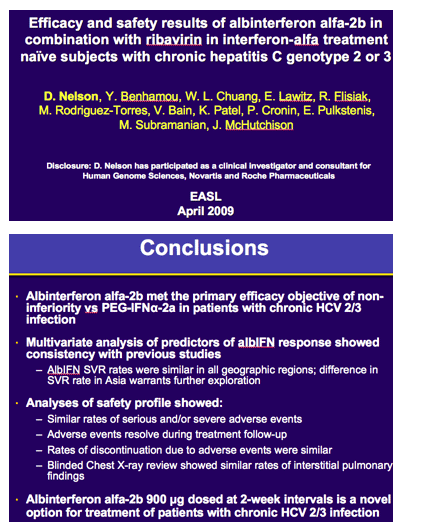
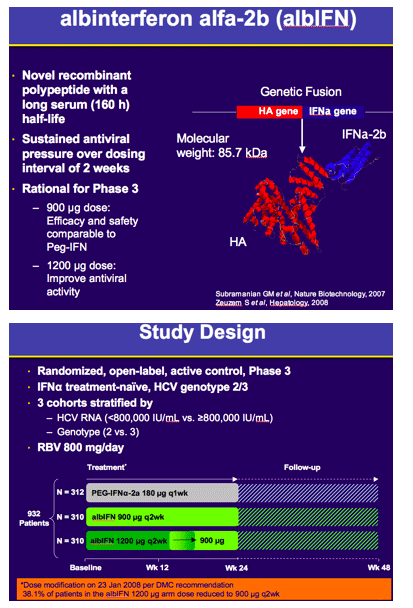
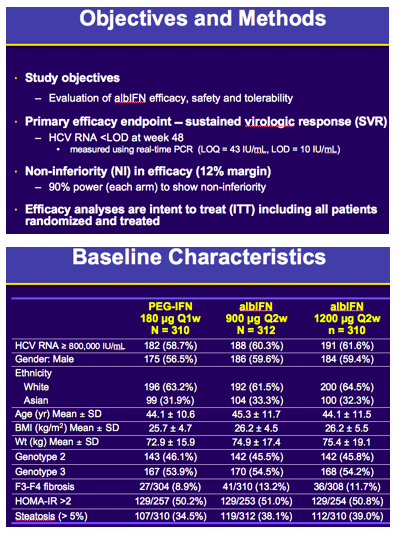
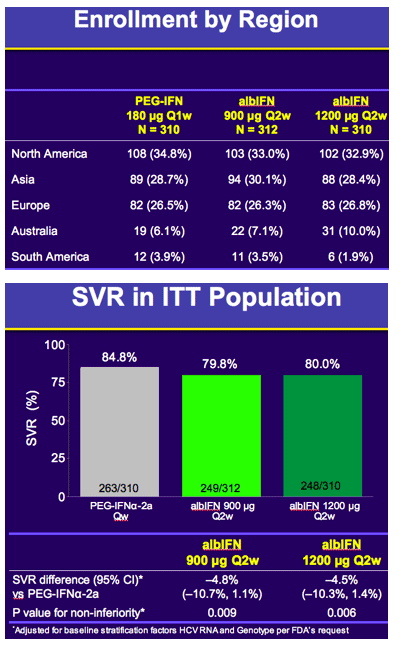
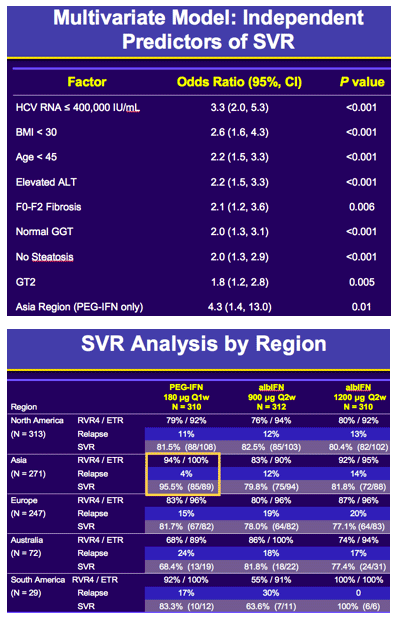
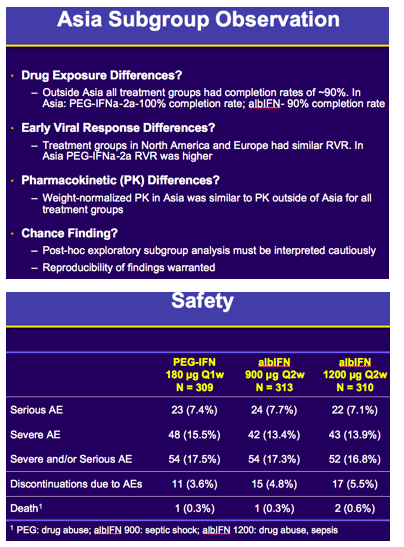
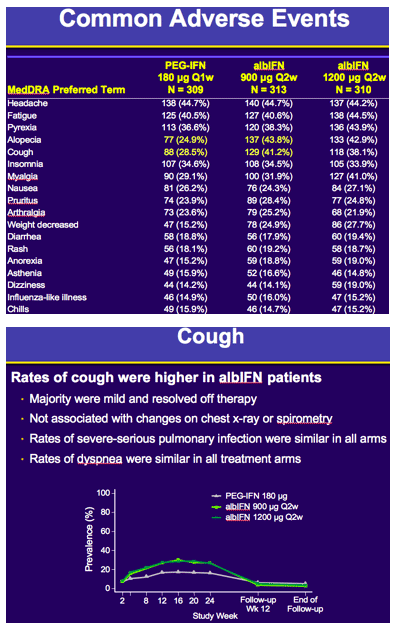
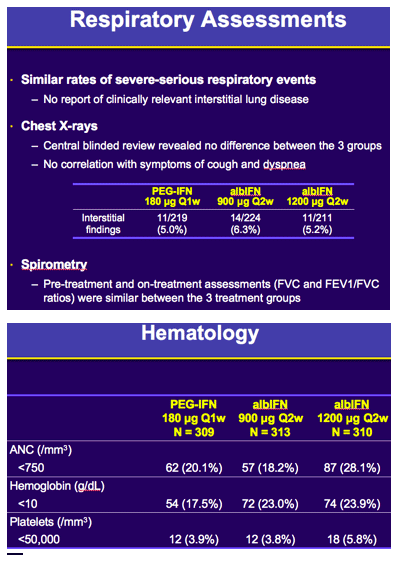
|
| |
|
 |
 |
|
|